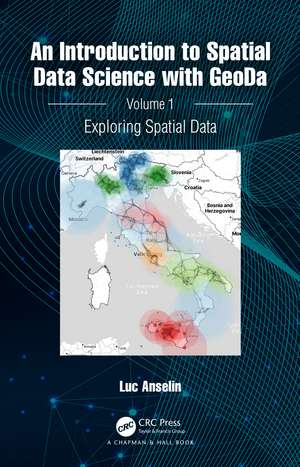An Introduction to Spatial Data Science with GeoDa: Volume 1: Exploring Spatial Data
Autor Luc Anselinen Limba Engleză Hardback – 26 apr 2024
The focus of the book is on intuitive methods to discover interesting patterns in spatial data. It offers a progression from basic data manipulation through description and exploration to the identification of clusters and outliers by means of local spatial autocorrelation analysis. A distinctive approach is to spatialize intrinsically non-spatial methods by means of linking and brushing with a range of map representations, including several that are unique to the GeoDa software. The book also represents the most in-depth treatment of local spatial autocorrelation and its visualization and interpretation by means of GeoDa.
The book is intended for readers interested in going beyond simple mapping of geographical data to gain insight into interesting patterns. Some basic familiarity with statistical concepts is assumed, but no previous knowledge of GIS or mapping is required.
Key Features:
• Includes spatial perspectives on cluster analysis
• Focuses on exploring spatial data
• Supplemented by extensive support with sample data sets and examples on the GeoDaCenter website
This book is both useful as a reference for the software and as a text for students and researchers of spatial data science.
| Toate formatele și edițiile | Preț | Express |
|---|---|---|
| Hardback (3) | 573.12 lei 3-5 săpt. | +26.81 lei 7-11 zile |
| CRC Press – 29 mai 2024 | 573.12 lei 3-5 săpt. | +26.81 lei 7-11 zile |
| CRC Press – 26 apr 2024 | 576.47 lei 3-5 săpt. | +39.07 lei 7-11 zile |
| CRC Press – 30 mai 2024 | 786.63 lei 6-8 săpt. |
Preț: 576.47 lei
Preț vechi: 633.49 lei
-9% Nou
Puncte Express: 865
Preț estimativ în valută:
110.31€ • 115.70$ • 91.83£
110.31€ • 115.70$ • 91.83£
Carte disponibilă
Livrare economică 11-25 martie
Livrare express 25 februarie-01 martie pentru 49.06 lei
Preluare comenzi: 021 569.72.76
Specificații
ISBN-13: 9781032229188
ISBN-10: 1032229187
Pagini: 444
Ilustrații: 730
Dimensiuni: 178 x 254 x 28 mm
Greutate: 0.98 kg
Ediția:1
Editura: CRC Press
Colecția Chapman and Hall/CRC
Locul publicării:Boca Raton, United States
ISBN-10: 1032229187
Pagini: 444
Ilustrații: 730
Dimensiuni: 178 x 254 x 28 mm
Greutate: 0.98 kg
Ediția:1
Editura: CRC Press
Colecția Chapman and Hall/CRC
Locul publicării:Boca Raton, United States
Public țintă
Postgraduate, Professional Training, and Undergraduate AdvancedCuprins
Chapter 1: Introduction. Chapter 2: Basic Data Operations. Chapter 3: GIS Operations. Chapter 4: Geovisualization. Chapter 5: Statistical Maps. Chapter 6: Maps for Rates. Chapter 7: Univariate and Bivariate Data Exploration. Chapter 8: Multivariate Data Exploration. Chapter 9: Space-Time Exploration. Chapter 10: Contiguity-Based Spatial Weights. Chapter 11: Distance-Based Spatial Weights. Chapter 12: Special Weights Operations. Chapter 13: Spatial Autocorrelation. Chapter 14: Advanced Global Spatial Autocorrelation. Chapter 15: Nonparametric Spatial Autocorrelation. Chapter 16: LISA and Local Moran. Chapter 17: Other Local Spatial Autocorrelation Statistics. Chapter 18: Multivariate Local Spatial Autocorrelation. Chapter 19: LISA for Discrete Variables. Chapter 20: Density-Based Clustering Methods. Chapter 21: Postscript - The Limits of Exploration. Appendices, Bibliography
Notă biografică
Luc Anselin is the Founding Director of the Center for Spatial Data Science at the University of Chicago, where he is also a Stein-Freiler Distinguished Service Professor of Sociology and the College, as well as a member of the Committee on Data Science. He is the creator of the GeoDa software and an active contributor to the PySAL Python open-source software library for spatial analysis. He has written widely on topics dealing with the methodology of spatial data analysis, including his classic 1988 text on Spatial Econometrics. His work has been recognized by many awards, such as his election to the U.S. National Academy of Science and the American Academy of Arts and Science.
Descriere
This book is the first in a two-volume series that introduces the field of spatial data science. It offers an accessible overview of the methodology of exploratory spatial data analysis. It also constitutes the definitive user’s guide for the widely adopted GeoDa open source software for spatial analysis.
